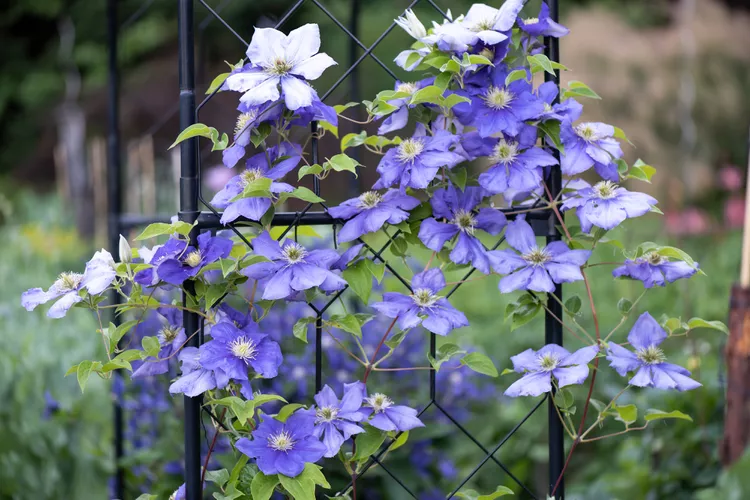Create more of your favorite varieties for free by learning how to propagate clematis. These hardy perennial vines come in hundreds of varieties that offer a diversity of colors and forms. If you were to collect and sprout seeds from your clematis, you may get plants that don't look like your original plant. To grow new plants that look exactly like the original variety, two of the best propagation methods to use are cuttings and layering. Follow this simple step-by-step guide to propagate clematis vines from layered stems or by rooting cuttings.
Propagating Clematis by Layering
Perhaps the easiest and most natural way to propagate clematis is by layering. Layering is a process by which plants sprout roots directly from their stems upon contact with soil. This technique may not work as well in cold climates where stems die back to the ground each winter.
Step 1: Select stems to layer.
Identify new, flexible stems in spring and lower them to the soil surface, whether in pots or onto the ground. Depending on the stem’s length, you might be able to create multiple clones along the length of the stem.
Step 2: Prepare stems.
Using a sharp knife, make a small cut into one side of each selected stem where it will make contact with soil. You can also apply a little powdered rooting hormone to the cut part of the stem.
Step 3: Cover the stems with soil.
Whether in the ground or in a nearby pot, press the cut part of each stem against the soil and lightly cover with about a half-inch to an inch of soil.
Step 4: Secure the stems in place.
Hold the buried portion of each stem in place beneath the soil with a small rock, garden pins, or a broken piece of pottery. Repeat the process if a stem is long enough to produce more than one plant, spacing them at least 6 inches apart.
Step 5: Water and wait.
Keep the buried portions of stem moist and disturb them as little as possible.
Step 6: Watch for new growth.
Over the course of one or two years, plantlets are likely to develop. Once you see new growth, cut the stem that attaches them to the parent plant to create fully independent plants. Gently dig up the new clematis vines and move them to where you want them to grow.
Propagating Clematis by Cuttings
Stem cuttings are a great way to make more clematis plants that usually grow within a single season.
Not all cuttings will take root and grow, so take several for success. Less than 50 percent of cuttings taking root is considered normal.
Step 1: Select stems of new growth.
Take softwood cuttings from newer, softer stems in late spring. Identify stems that have just begun to harden for best results. These stems are ready and capable of producing roots of their own.
Step 2: Take cuttings.
Separate the chosen stem from the rest of the plant by cutting it off at the base.
Step 3: Remove leaves.
The stem consists of a series of nodes from which leaves sprout on either side every few inches. Remove the leaves at the base of each node along the entire length of the stem, leaving some leaves above each node.
Step 4: Prepare cuttings.
Cut the stem into sections 3 to 4 inches long, making the cut just below a node. Each section should have a node, a portion of stem, and one set of leaves.
Step 5: Apply rooting hormone.
Dip about 1 inch of each section into a rooting hormone, then let them sit for a few minutes until dry.
Step 6: Plant cuttings.
Prepare a 4- or 5-inch container of moist potting soil and poke holes along the edges with a pencil or pen. Gently place cuttings into the soil and press the soil against the stems, holding them in place.
Step 7: Care for cuttings until they root.
Place the planted cuttings in bright, indirect light, dappled shade, or under artificial lighting, and keep the potting soil moist. Cuttings should root and begin to produce new growth within two to three months, depending on climate and other environmental conditions.
Caring for Your Clematis Cuttings
Once the cuttings have begun to take root and grow, move them to individual pots and provide plenty of sunlight and moisture. Apply light doses of an organic fertilizer following the product instructions to help the new plants grow and prepare for the following season.
As the clematis cuttings begin to mature in about a year, plant them in the garden. Established cuttings are just as hardy as their parent plants and need the same amount of care.




















